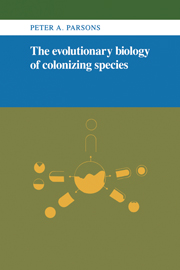Book contents
- Frontmatter
- Contents
- Preface
- 1 Introduction: Colonists and habitats
- 2 Genetics and ecology
- 3 Physical conditions, resources, and ecological phenotypes
- 4 Variability in natural populations
- 5 Genetic variability, ecological phenotypes, and stressful environments
- 6 Colonizing phenotypes and genotypes
- 7 Behavioral variability in natural populations
- 8 Habitat selection
- 9 The ecobehavioral phenotype: generalists and specialists
- 10 The ecobehavioral phenotype: biological control and domestication
- 11 Parasites and plants
- 12 Discussion and conclusions
- Appendix The study of quantitative traits
- References
- Index
1 - Introduction: Colonists and habitats
Published online by Cambridge University Press: 15 September 2009
- Frontmatter
- Contents
- Preface
- 1 Introduction: Colonists and habitats
- 2 Genetics and ecology
- 3 Physical conditions, resources, and ecological phenotypes
- 4 Variability in natural populations
- 5 Genetic variability, ecological phenotypes, and stressful environments
- 6 Colonizing phenotypes and genotypes
- 7 Behavioral variability in natural populations
- 8 Habitat selection
- 9 The ecobehavioral phenotype: generalists and specialists
- 10 The ecobehavioral phenotype: biological control and domestication
- 11 Parasites and plants
- 12 Discussion and conclusions
- Appendix The study of quantitative traits
- References
- Index
Summary
An important milestone in the development of ecological population genetics was the symposium sponsored by the International Union of Biological Sciences at Asilomar, California, in 1964 on The Genetics of Colonizing Species.
[Stebbins, 1979:40]This quote is provided to indicate that the most significant previous major publication on the theme of this book is the volume recording the activities of the 1964 symposium (Baker and Stebbins, 1965). The volume from this conference contains many leads. Many are today not fully developed. A summary of many of the questions posed appears in the symposium's Introduction (Waddington, 1965) and the Summary (Mayr, 1965). Before reopening some of these issues, however, it is important to consider briefly what is meant by the term colonizing species, not as an absolute definition, but to set the scene for the chapters that follow. This is simply because the borderline between a colonizing species and a noncolonist is arbitrary and defined mainly by accepted usage.
At one extreme, every species is a colonist, since otherwise it would not occupy any territory. This extremely broad definition is, however, of little practical use. Often in the literature, considerations are restricted to species invading disturbed and newly created habitats following humans. With increasing urbanization and the destruction of natural habitats, such species are increasing in importance year by year. Among these species, many insects, certain rodents, and weedy plants are notably important (Baker and Stebbins, 1965). Among the insects, some of the widespread species of the dipteran genus Drosophila are important as colonizing species and have been extensively studied.
- Type
- Chapter
- Information
- The Evolutionary Biology of Colonizing Species , pp. 1 - 8Publisher: Cambridge University PressPrint publication year: 1983



